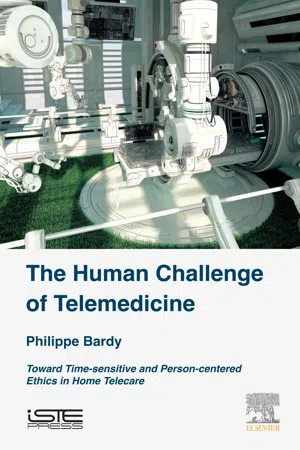
The Human Challenge of Telemedicine
Toward Time-sensitive and Person-centered Ethics in Home Telecare
- 284 pages
- English
- ePUB (mobile friendly)
- Available on iOS & Android
The Human Challenge of Telemedicine
Toward Time-sensitive and Person-centered Ethics in Home Telecare
About this book
Telepatients using connected objects to collect time-sensitive data about their health are not neutral carriers of diagnosable symptoms. Patients are persons, or personal beings as well as co-carers, whose personal experience, history and know-how must be acknowledged in time-sensitive telecare practices. Such practices require a relational ethics, inspired by medical ethics and an ethics of virtues, focusing on vulnerability and emotional health, to oversee telecare good practices, define a new therapeutic alliance compliant with patients' values, and reconcile the technical and human sides of telemedicine.- The ethical challenges of telemedicine in chronic patients today- The key features of a person-centered and relational ethics in telemedical settings- The concepts of "emotional health care and "chrono-sensitivity of the "connected sick body
Frequently asked questions
- Essential is ideal for learners and professionals who enjoy exploring a wide range of subjects. Access the Essential Library with 800,000+ trusted titles and best-sellers across business, personal growth, and the humanities. Includes unlimited reading time and Standard Read Aloud voice.
- Complete: Perfect for advanced learners and researchers needing full, unrestricted access. Unlock 1.4M+ books across hundreds of subjects, including academic and specialized titles. The Complete Plan also includes advanced features like Premium Read Aloud and Research Assistant.
Please note we cannot support devices running on iOS 13 and Android 7 or earlier. Learn more about using the app.
Information
The Advent of Digital Healthcare
Abstract
Keywords
1.1 Digital healthcare as an ecosystem

| Telemedicine stakeholders | Telemedicine companies |
| Software publishers | McKesson, CompuGroup Medical, Corwin, Medisys, Meditrans |
| IT service providers | IT services providers/integrators such as Atos Origin or Sopra Group |
| Manufacturers of medical devices | Philips, Biotronik, Medtronic, Sorin, GE Healthcare, Nx Stage, Physidia |
| Health data hosts | 2CSI, Carestream Health, Cegedim, Cerner, Sigems |
| Telecom operators | Orange, Deutsche Telekom, British Telecom, SFR |
| Telemedicine and telehealth service providers | Intervox, H2AD, Wengo Santé, N2TS, Adechotech, Hailadoc, Teckel Medical, MedGo, Phemium |
| Associations and professional bodies | Missions |
|---|---|
| CATEL – Club des acteurs de la télésanté [Telehealth Stakeholders Club] | National e-health reference organization in France. Since 1997, its mission has been to contribute to the development of telehealth, telemedicine and e-health in all its fields of application4. |
| Société Française de Télémédecine [French Telemedicine Society] | Developing telemedicine research to improve patient management5. |
| Société internationale de télémédecine et eSanté [ISFTeH - International Society of Telemedicine and e-health] | Facilitating the dissemination of knowledge and know-how in telemedicine and digital health, as well as access to internationally recognized professionals in these fields of expertise6. |
| Agir pour la télémédecine (Association loi 1901) [Taking action for telemedicine (Law Association 1901)] | Facilitating telemedicine deployment and collaboration between stakeholders7. |
| Société Européenne de Télémédecine [European Telemedicine Society] | Stimulating basic, epidemiological, technological and operational research in the field of telemedicine and supporting research programs8. |
- – the Délégation à la stratégie des systèmes d’information (DSSIS, Information Systems Strategy Delegation);
- – the Agence des systèmes d’information partagés de santé (ASIP Santé, Agency for Shared Health Information Systems);
- – the Agences régionales de santé (ARSs, French Regional Health Agencies);
- – the Délégati...
Table of contents
- Cover image
- Title page
- Table of Contents
- Copyright
- Acknowledgments
- Introduction: Temporalities and Psycho-Emotional Dimension of the Technicality of Care
- Part 1: The Person in the Age of Telecare
- Part 2: Telecare Phenomenology
- Part 3: Toward an Ethics of “Time-sensitive” Telecare
- Conclusion: Reconciling the Humanity and Technicality of care
- List of Abbreviations
- References
- Index